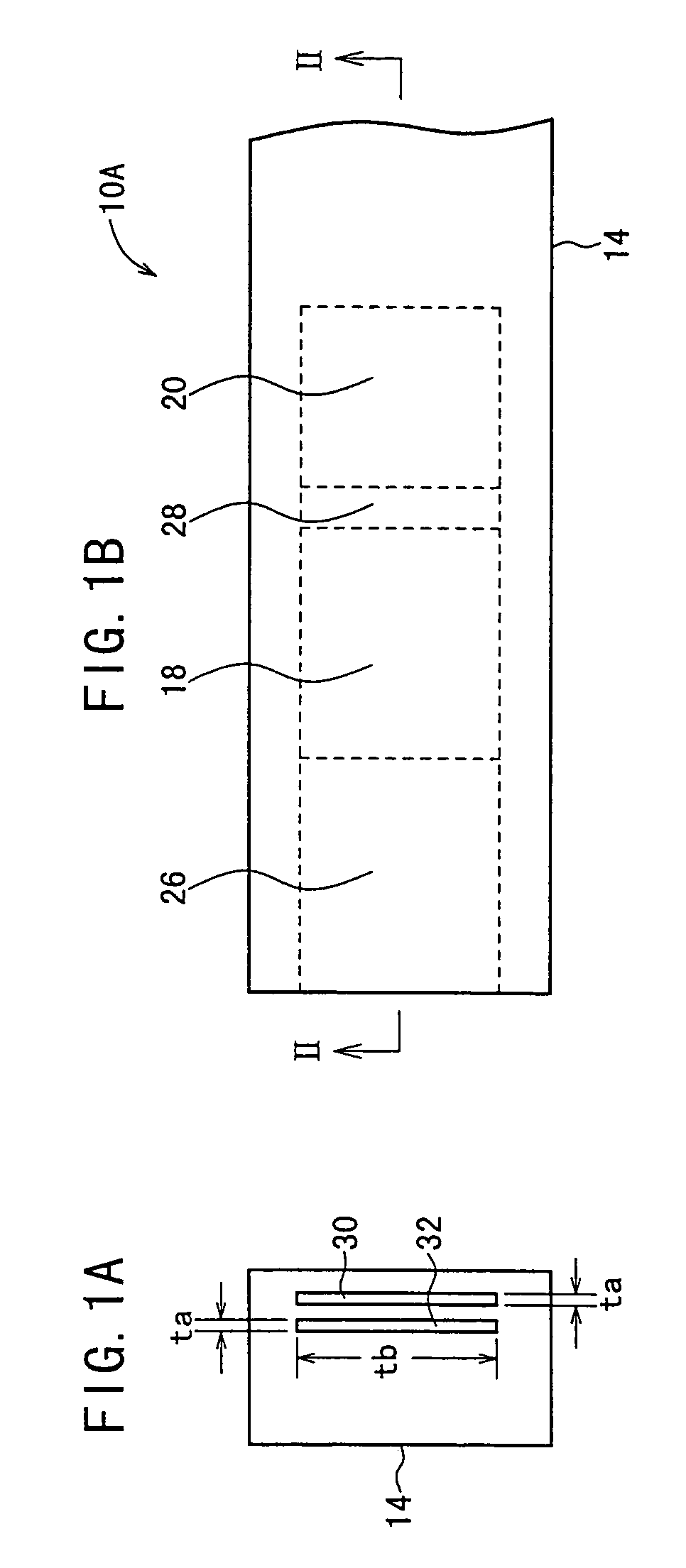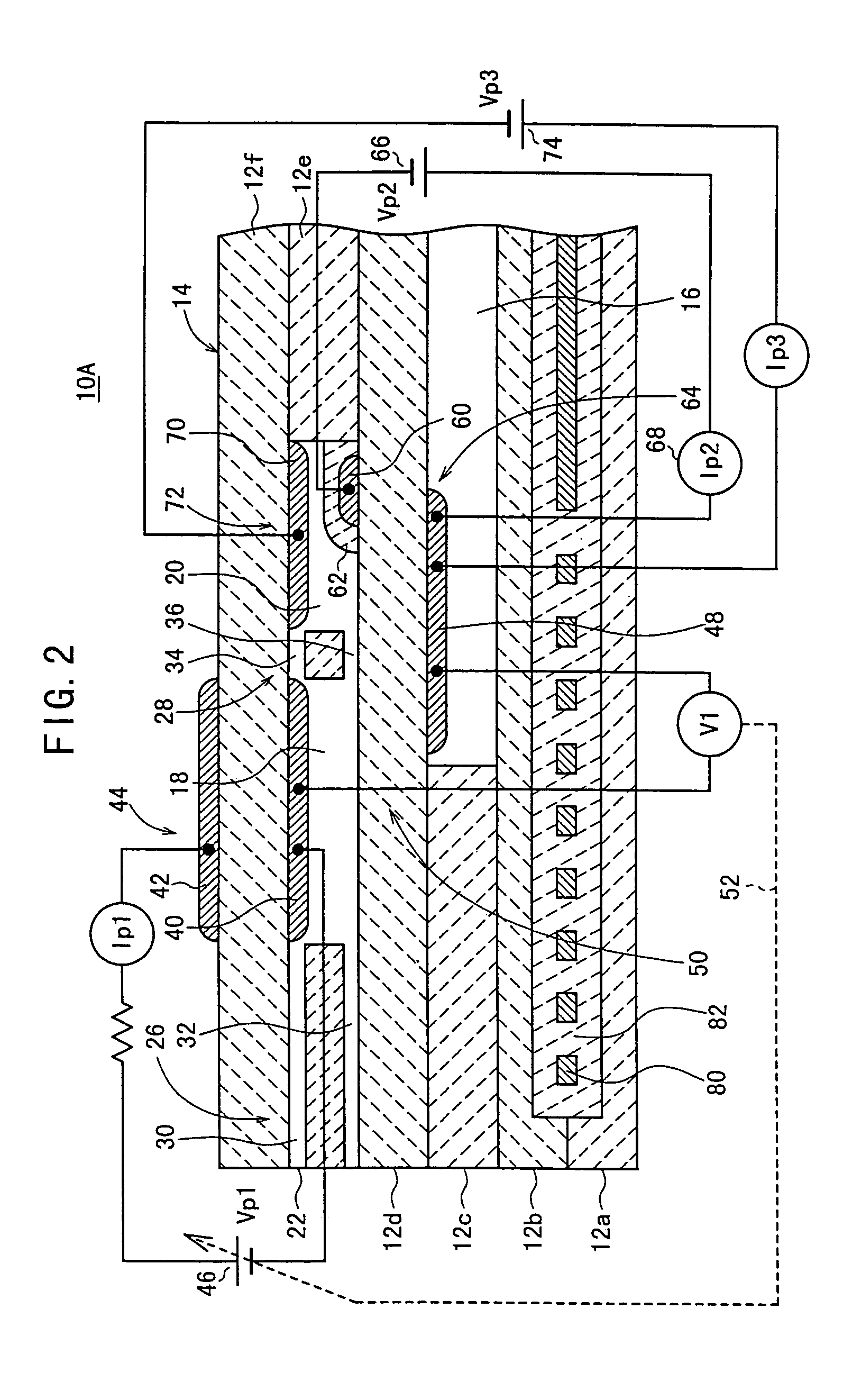Gas sensor and nitrogen oxide sensor
a technology which is applied in the field of gas sensor and nitrogen oxide sensor, can solve the problems of inability to perform the measurement of a combustion gas produced under such a combustion condition, the influence of noise of conventional sensors, and the suffering of the above-mentioned sensors, so as to improve the measurement accuracy
- Summary
- Abstract
- Description
- Claims
- Application Information
AI Technical Summary
Benefits of technology
Problems solved by technology
Method used
Image
Examples
first embodiment
[0082]As shown in FIGS. 1A, 1B, and 2, a gas sensor 10A includes a sensor element 14 provided with a substrate comprising, for example, six stacked solid electrolyte layers 12a to 12f composed of ceramics based on the use of oxygen ion-conductive solid electrolytes such as ZrO2.
[0083]In the sensor element 14, first and second layers from the bottom are designated as first and second substrate layers 12a, 12b respectively. Third and fifth layers from the bottom are designated as first and second spacer layers 12c, 12e respectively. Fourth and sixth layers from the bottom are designated as first and second solid electrolyte layers 12d, 12f respectively.
[0084]A space 16 (reference gas-introducing space 16), into which a reference gas such as atmospheric air to be used as a reference for measuring oxides is introduced, is formed between the second substrate layer 12b and the first solid electrolyte layer 12d, the space 16 being comparted by a lower surface of the first solid electrolyt...
first modified embodiment
[0134]At first, as shown in FIGS. 13A, 13B, and 14, a gas sensor 10Aa differs in that the first and second diffusion rate-determining sections 26, 28 are formed by single laterally extending slits 110, 112 respectively.
[0135]Specifically, the first diffusion rate-determining section 26 includes the slit 110 having a laterally extending aperture formed at a front end portion of the second spacer layer 12e to make contact with the upper surface of the first solid electrolyte layer 12d, the aperture being formed to extend with an identical aperture width up to the first chamber 18. The second diffusion rate-determining section 28 includes the slit 112 having an aperture formed at a terminal end portion of the first chamber 18 of the second spacer layer 12e to make contact with the upper surface of the first solid electrolyte layer 12d, the aperture being formed to extend with an identical aperture width up to the second chamber 20. In the first modified embodiment, each of the slits 1...
second modified embodiment
[0136]Next, as shown in FIGS. 15A, 15B, and 16, a gas sensor 10Ab differs in that the first and second diffusion rate-determining sections 26, 28 are formed by single laterally extending wedge-shaped slits 114, 116 respectively.
[0137]Specifically, the first diffusion rate-determining section 26 includes the wedge-shaped slit 114 having a laterally extending aperture formed at a front end portion of the second spacer layer 12e to make contact with the upper surface of the first solid electrolyte layer 12d, the aperture being formed to extend with an aperture width (width in the vertical direction) gradually enlarged toward the first chamber 18. The second diffusion rate-determining section 28 includes the wedge-shaped slit 116 having a laterally extending aperture formed at a terminal end portion of the first chamber 18 of the second spacer layer 12e to make contact with the upper surface of the first solid electrolyte layer 12d, the aperture being formed to extend with an aperture ...
PUM
| Property | Measurement | Unit |
|---|---|---|
| length tb | aaaaa | aaaaa |
| length tb | aaaaa | aaaaa |
| partial pressure | aaaaa | aaaaa |
Abstract
Description
Claims
Application Information
 Login to View More
Login to View More - R&D
- Intellectual Property
- Life Sciences
- Materials
- Tech Scout
- Unparalleled Data Quality
- Higher Quality Content
- 60% Fewer Hallucinations
Browse by: Latest US Patents, China's latest patents, Technical Efficacy Thesaurus, Application Domain, Technology Topic, Popular Technical Reports.
© 2025 PatSnap. All rights reserved.Legal|Privacy policy|Modern Slavery Act Transparency Statement|Sitemap|About US| Contact US: help@patsnap.com



